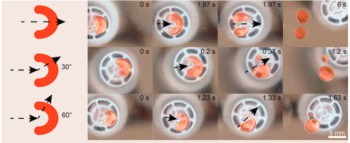Flapping sails and fluttering flags have intrigued physicists for well over a century. Yet the complicated interaction between a flexible object like a flag and its surrounding fluid is not fully understood. Now an experiment by Jun Zhang and co-workers at New York University and Rockefeller University in the US has shed new light on how flags flap in a breeze (J Zhang et al 2000 Nature 408 835). By suspending a fine silk thread in a fast-flowing soap film, the team has studied the simplified case of a one-dimensional flag in a two-dimensional 'wind'.

Zhang and colleagues found that the filaments – which are several centimetres long – have two distinct stable states depending on their length. Below a certain threshold the filament stretches out straight, in line with the fluid flow. Even when the researchers nudge the filament to encourage it to flap, it quickly returns to the stable ‘stretched-out’ state. But above this critical length, a sufficiently large disturbance causes the filament to jump to a stable flapping state. This state is quite robust and persists even after attempts to disturb it. “This refutes the common belief that a flag always flaps in the wind”, Zhang told PhysicsWeb. “Here we see two stable states under the same conditions. It was quite surprise to us.” Zhang’s team compares the two states to swimming: the stretched-out phase is analogous to a swimmer gliding through water and the flapping state corresponds to the swimmer using the oscillations of their body to propel themself through the water.
In the straight configuration, the filament produces a train of vortices – alternating between clockwise and anti-clockwise – that trail from its free end. Zhang’s team noticed that the shape of this train changes dramatically when the filament is in its stable flapping state – and that adjacent vortices tend to rotate in the same direction.
If the filament is very long, the stable stretched-out state disappears, leaving only the stable flapping state, but this behaviour remains mysterious. At these lengths, only the end of the filament oscillates. Zhang’s team believes that this effect, in common with the other phenomena, arise from the tension, mass and elasticity of the filament – features usually overlooked in fluid dynamics – together with the interaction between the filament and the fluid flow. “On the one hand, this is one of the simplest experiments I have ever done”, said Zhang, “but on the other hand, it is one of the most complex phenomena in hydrodynamics”.



